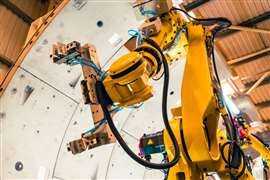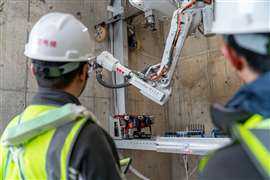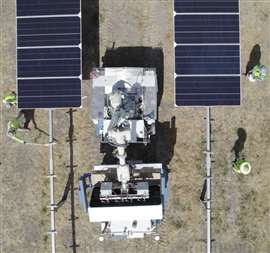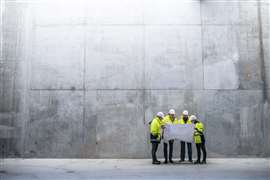Read this article in Français Deutsch Italiano Português Español
What useful jobs can robots perform on sites (and what can’t they do)?
19 August 2025
 ARTIS, a robotic-AI prototype for tunnelling work developed by a five-organisation consortium based in the UK. (Image: Andrei Zota/Costain)
ARTIS, a robotic-AI prototype for tunnelling work developed by a five-organisation consortium based in the UK. (Image: Andrei Zota/Costain)
Construction sites present some of the toughest environments for automation but could the spectre of AI-powered robots taking jobs from humans be on the horizon?
Yes and no, according to a new report from management consulting firm McKinsey.
Uneven terrain, variable weather, unpredictable workflows and diverse materials make construction sites harder to navigate than the controlled conditions of warehouses or factories.
But according to McKinsey’s report, Will embodied AI create robotic coworkers?, advances in “general-purpose” machines powered by embodied AI and capable of adapting to different tasks are starting to open up new possibilities even in this sector.
The research highlights where these robots are best placed to add value on site today and where limitations still apply.
In construction, the strongest potential lies in “pick and place” activities. These include:
- Picking and placing light or small objects (where McKinsey rates AI-powered robots as having a high capability within construction)
- Picking and placing heavy or large objects (high capability)
- Picking and pouring small containers (high capability)
However, their capabilities drop sharply for more complex or dexterous site tasks:
- Picking and pouring large containers (low capability)
- Pointing and directing small tools (low capability)
- Pointing and directing large instruments (low capability)
- Pointing and directing non-rigid items such as cables or flexible materials (low capability)
The findings suggest that while robots could perform basic tasks on site, anything requiring fine tool control, interaction with flexible materials (such as cables or fabric), or complex assembly is still likely to be beyond them.
Robots - even those equipped with AI - still appear to have limitations in robotic dexterity and tactile sensing, which is potentially good news for human workers fearful for their jobs. McKinsey notes that even the most advanced humanoid hands offer fewer degrees of freedom than human hands, making delicate or irregular tasks difficult.
 Schindler R.I.S.E is the world’s first self-climbing robot that is designed to maneuver itself along the building’s elevator shaft to install components. (Image courtesy of Schindler)
Schindler R.I.S.E is the world’s first self-climbing robot that is designed to maneuver itself along the building’s elevator shaft to install components. (Image courtesy of Schindler)
Other constraints
The constraints aren’t just mechanical either. As with battery-electric machines, power supply is a another key bottleneck. Humanoid robots typically operate for only two to four hours on a charge when performing dynamic tasks, McKinsey’s report said. Heavy lifting accelerates battery drain, while recharging and battery-swapping infrastructure is still immature. This limits the viability of deploying robots for a full construction shift without interruption.
Then there’s the issue of cost. General-purpose robots can range from US$15,000 to $250,000 per unit, with payback periods often exceeding two years in early trials, the report notes. Maintenance is expensive and can involve long downtimes if repairs require shipping to specialist facilities. In an industry where margins are thin, the economics can be difficult unless robots are deployed at scale or for high-value applications.
 An overhead view of the robot picking up a PV module. The robot picks modules from autonomous module carriers that work with it. (Photo: Rosendin)
An overhead view of the robot picking up a PV module. The robot picks modules from autonomous module carriers that work with it. (Photo: Rosendin)
Integration into the construction workflow also presents barriers. Many existing robots are assembled from bespoke parts, with no agreed industry standards. This creates supply chain risks and complicates system integration. For construction contractors, that means each deployment can feel like a bespoke project, rather than a plug-and-play solution.
Despite these challenges, McKinsey’s researchers noted that the trend towards embodied AI also brings positives with it. Improvements in vision-language-action foundation models (the “brains” of modern robots) are allowing them to interpret visual cues, follow spoken instructions and learn from observation. This could enable more flexible deployments in environments designed for humans, such as building sites, without the need for major redesigns.
Nonetheless, industry sectors other than construction are likely to see faster adoption of AI-embodied robots. McKinsey’s modelling suggests warehouse logistics, light manufacturing, retail, agriculture and healthcare are better suited in the short term.
That’s because of more predictable settings and stronger short-term return on investment. Even so, the report argues that forward-looking construction companies should begin exploring pilot projects now.
The speed of adoption also relies on more than just the technology available: economics, regulation and workforce readiness will shape the use of robots in construction as much as the engineering, the report notes. That means carefully targeted pilots, a focus on measurable returns, and a realistic view of what robots can and cannot do on site today.
For companies considering their options, McKinsey advises:
- Set a long-term automation vision: Identify where robotics could fit into the construction process.
- Invest in data: Robots learn best from rich, physical-interaction data. Capturing and structuring site-specific data now could help train future systems.
- Monitor enabling technologies: Track progress in battery density, tactile sensing, dexterity and regulatory frameworks rather than relying on marketing demos.
- Prepare the workforce: Don’t wait for robots to arrive before upskilling the workforce. Start building the talent and culture needed to work alongside machines.
- Build partnerships: Engage with robotics start-ups, join industry standards groups, and adapt infrastructure to be robot-ready.
STAY CONNECTED


Receive the information you need when you need it through our world-leading magazines, newsletters and daily briefings.
CONNECT WITH THE TEAM











